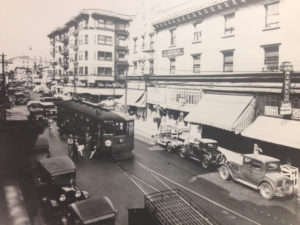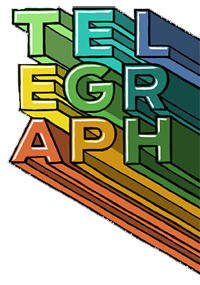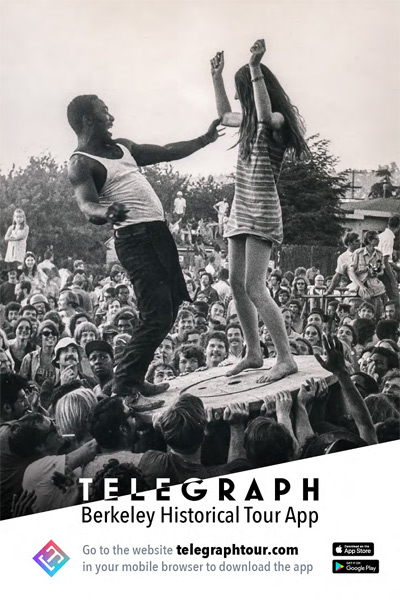 The Beginning
The Beginning
Telegraph Avenue was born in 1858 when a telegraph line was built between Oakland and Sacramento. The two streets that ran parallel to the East Bay portion of the line were fused and renamed The Telegraph Road. Over the next 10 years, the road’s path shifted, eventually running right into UC Berkeley (which relocated from Oakland in 1873). The thoroughfare was later renamed Telegraph Avenue, and the name stuck. As the first ever University of California campus, UC Berkeley had no shortage of incoming students and began to expand its facilities. In 1910, the University built Sather Gate. Berkeley’s reputation as an elite academic destination was cemented by the 1950s and the city was evolving into a bohemian, Cambridge-like community. It was a charmed period for Telegraph Avenue, but one that would soon be interrupted.
Making History
The 1960s ushered in an era rife with political, social, and ideological conflict; it was during this time that Telegraph Avenue became a beacon for a new generation. Things heated up during fall semester, 1964, when Jack Weinberg was arrested and put in a squad car for defying a campus mandate against on-campus recruitment for off-campus activities. Over the next 32 hours, the Free Speech Movement was born (Click Here for a visual history of the Free Speech Movement). That’s how long Weinberg remained in the police car, which was immediately swarmed by protesting students. In a now famous act, memorialized in a mural on Haste Street at the Telegraph Avenue intersection, Mario Savio leapt atop the police car and exhorted his fellow students to demand their right to free speech. The University later relented and things quieted — for a time. Beginning in the mid-1960s, the war in Vietnam ignited many protests on Telegraph. Then in spring 1969, the avenue was thrust into the national spotlight. In the early weeks of May, Berkeley residents and students claimed an empty lot owned by UC Berkeley. They planted trees and sod and dubbed the lot People’s Park. On May 19, Alameda County Sheriff Officers and Berkeley police were dispatched to disband the squatters. Over the next few hours, the conflict between police and the protesters escalated. The result: blockades, tear gassings, and one protester’s death. Governor Ronald Reagan then called in the National Guard to assist local law enforcement. On May 30, Berkeleyans were awarded a permit to march peacefully in support of People’s Park. Eventually, the lot reemerged as an urban city park.
The Dust Settles
Following the People’s Park incident, protests slowed and the cultural climate began to shift away from the radicalism that had taken hold. In the ‘70s, Telegraph Avenue became a popular destination for eccentric young drifters and counter culture intellectuals. Though always known for its diversity and tolerance, the Telegraph community grew even more multicultural and vibrant.
Throughout the 1980s and most of the ‘90s, Telegraph remained a colorful escape for Northern California day tourists, as well as visitors from around the world. Telegraph’s unique shops and restaurants such as Blake’s, The Reprint Mint, Lhasa Karnak Herbs, and Bill’s Men’s shop served both regulars and tourists alike. By then, UC Berkeley was the preeminent public institution in the world, continuing to turn out celebrated scholars, scientists, and future leaders. But the new millennium brought change. Online shopping and digital downloading made it difficult for Telegraph’s book and music stores to keep up. So in true Telegraph fashion, they adjusted to the times, amping up their rare and used inventory. Now Telegraph boasts an enormous new and used product inventory second to none in the Bay Area. As time marches on, the Telegraph community is committed to preserving the originality of this cosmopolitan neighborhood. They do this by supporting an open-minded, multicultural atmosphere that will attract a new generation of keen minds and hearts. With its street fairs, live performances, and world-class people-watching, Telegraph continues its legacy as the most intriguing street in the East Bay.


 The Beginning
The Beginning